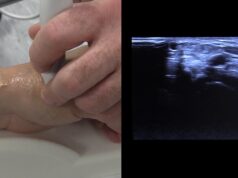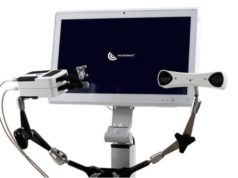This advertorial is sponsored by Merit Medical.

Consultant interventional radiologist Damian Mullan (The Christie NHS Foundation Trust, Manchester, UK) speaks to Interventional News about his experiences with Merit Medical’s Temno Elite™ biopsy system at his hospital, the largest single-site cancer centre in Europe. Among the benefits of using the product for cancerous and non-cancerous soft tissue biopsies alike, Mullan emphasises its ability to yield a larger and less fragmented sample with better macroscopic and microscopic visibility compared to other biopsy needles. This advantage is complemented by the intuitiveness of the design, allowing even those using the system for the first time to do so while reaping the benefits of the Temno Elite’s “unique” features.
Mullan first outlines the obstacles that he and colleagues have historically faced when it comes to carrying out soft tissue biopsies. “Our main challenge is getting a sufficient volume of tissue to satisfy needs for histological diagnosis, for clinical trials and for tissue banking. A good-quality sample is vital, as every biopsy has inherent risks, and you do not want to repeat a biopsy simply because the sample is insufficient despite accurate biopsy placement. The Temno Elite enables the clinician to take a good-quality sample first time, and in a safe manner for the patient”, according to Mullan.
Moving on to speak on the key features Temno Elite boasts, Mullan mentions the “cored-out” bevel, which “produces up to a 72% larger sample1 than previous side-notch needle systems. This can provide a similar bulk of tissue with fewer biopsy passes or allow confidence that a smaller gauge biopsy will give you a similar bulk of tissue to current needle systems. You now do not have to upsize your needle and puncture hole to get a better quality sample,” he underlines.
In addition, he explains how the sample assist feature is key to allowing delivery of a non-fragmented sample to your histopathologist. “It allows you to atraumatically slide the biopsy sample off the bevel, avoiding having to scrape it off with a scalpel or swirl in formalin, and this avoids fragmentation. A non-fragmented sample is crucial for liver and renal biopsy where you are looking for a continuous piece of tissue to ascertain the number of continuous portal triads or the ratio of glomeruli to fibrosis.” In combination, he summarises, these two features aid the diagnostic yield when sampling, for cancer and non-cancer patients alike. He adds: “It is visually and microscopically better and appears as if you are getting a sample from a traditional forward-cutting needle—they are good, solid cores.”
Ease of use is a further consideration that the Temno Elite accounts for, Mullan avers, dubbing it “very intuitive”. This is in contradistinction, he notes, to “some other needle systems, which, if you handed to a colleague with no experience of that system, they would find it difficult to understand how to load and fire the system until they had used it 10 or 20 times. However, if you hand over a Temno Elite, it is a case of ‘point-and-click biopsy’, it is ergonomic intuition.” Mullan describes the new system overall, in this regard, as “a nice, stepwise evolution of the previous Temno systems. You do not need instruction or repetition to become immediately familiar with it”.

Regarding the safety profile, Mullan refers to unique advantages offered by the Temno Elite. Lung biopsy, specifically, is “a procedure that can carry significant morbidity.” There are well recognised risks of pneumothorax and haemothorax, and the rare, but very serious, risk of air embolism, which can be fatal. There can be a certain amount of stress to the operator because you are cognisant of those risks, so having the confidence of using a system that is designed to prevent some of these risks is very reassuring,” he conveys.
“Lung biopsies can be technically challenging if you are a single operator, as you will perform the biopsy, and then perform a little ‘dance’ around the sample pot, either plugging the Coaxial Introducer with one finger, or resheathing with the Introducer stylet needle, all whist trying to simultaneously get the sample into a pot by any means necessary. The Temno Elite valved Coaxial Introducer has a one-way valve mechanism which means you have the luxury of knowing that you are not going to get air ingress or an air embolism, or any bleeding to the outside, during transfer of biopsy specimen into a sample pot. The one-way valve could also, theoretically, reduce the track bleeding which is an inevitable consequence of inserting and removing the biopsy needle—as the blood is not going to egress, and is more likely to form a clot within the biopsy site,” Mullan posits.
“[IT] produces up to a 72% larger sample than previous side-notch needle systems.”
“This all makes for a much less stressful procedure because you have confidence that you are not rushing through [it]. The Temno Elite lends itself nicely to how you should want to do a procedure, which is in a controlled, concise, methodical and safe fashion.” Mullan follows this up by stating that the Temno Elite is geared towards use for multiple types of biopsy, with a range of gauge and length options. “The quality of the sample and the size means that it is relatable to any biopsy, [not only lung and liver] because you will get a better quality sample than with traditional flat-cutting bevel needles. It is an evolution of previous needle systems, so it is not too different, just better. Across the board, whether for renal, peritoneal, [or others], it does seem to give a better sample.”
On the topic of testing, Mullan proceeds to share his experience—“we have performed bench-side tests, ex vivo, with a calf’s liver to assess the number of portal triads, and it did give us a significant increase in the number compared to older flat-cutting bevel systems.” In theory and in practice, “fragmentation is significantly less with the Temno Elite system”.
Commenting on real-life use, Mullan explains how the cored-out bevel does make the needle tip slightly more prone to bending and distortion (in comparison to a flat bevelled needle), but “only if you are aggressive with manipulation in tissue. One would argue that any biopsy should be precise and targeted, avoiding excess torque and aggressive manipulation.”
Concluding, Mullan provides anecdotal evidence, proving that the Temno Elite “tells its own story” when it comes to the advantages it bestows upon the operator. Recently, when going to take the needle system off the shelf in preparation for a biopsy procedure, he discovered that he had used up the stock of Temno Elite faster than expected and was waiting for new Temno Elite stock inventory to arrive—“I was really disappointed to not be able to use it, and genuinely very frustrated that I did not have the needle to hand. It is so intuitive, that once you start using it and seeing the better sample that it gives you, it becomes difficult not to use it.”
DISCLAIMER: Before using any product, refer to the instructions for use2 (IFU) for indications, contraindications, warnings, precautions, and directions for use. Temno Elite Biopsy System is intended for use in obtaining biopsies from soft tissues such as liver, kidney, breast, prostate, spleen, lung, lymph nodes, thyroid, and various soft tissue masses. It is not intended for use in bone. The valved Coaxial Introducer needle and standard Coaxial Introducer needles are intended for use as guiding needle in obtaining core biopsy samples from soft tissue such as liver, kidney, prostate, spleen, lung, lymph nodes, thyroid, and various soft tissue masses. It is not intended for use in bone.
¹ 401117001.pdf (merit.com); Internal testing with 18G. Data on File. Marketing Claims for the TEMNO Elite Device (ECN147270)
² https://cloud.merit.com/catalog/IFUs/404114002.pdf











